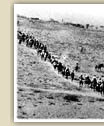|
The rise of Turkish nationalism and economic interests related, to a large extent, with Germany's economic infiltration of the Ottoman Empire, led to a systematic persecution of Greeks between 1913 and the Asia Minor Campaign.
|

Persecutions can be divided into three categories according to the intensity and
outcome of the persecutions.
Thus, in the period 1913-14, we have the first phase of persecutions. Relations between
Greece and Turkey were strained because of the grant of the islands of
the north-eastern Aegean to Greece. The persecutions began with the violent deportation
of the Greeks of eastern Thrace, and from May 1914 expanded to
western Asia Minor. Instead of Greeks, Turkish refugees settled
in the territories Turkey had lost in the Balkan Wars.
Engineered by the Germans, the persecutions expelled 130,000 Greeks
from Erythrea. Many of the refugees fled to Greece, whereas the rest were
deported to the interior of Asia Minor. It was then that a partial exchange
of populations was decided, and a Mixed Committee established to assess
the property of the exchanged populations. According to the statistics of the
Ecumenical Patriarchate, 153,890 Greeks were deported to the interior from the coasts
of Asia Minor up to the end of 1914.
The second phase of persecutions began with the involvement of Turkey in
the First World War. It initially took the form of economically draining Greeks for the needs of the war. Another measure, which was
initially proclaimed as an embodiment of the principle of equality between the
nationalities of the Empire, was military service (for all males between the ages of 20 and 45), while older men were recruited for the notorious
amele taburu, labour batallions, which meant hard labour in quarries, fields, mines and
public works in the interior of Asia Minor. Hardships eliminated many Greeks.
It is estimated that by the end of 1918 250,000 Greeks had lost their lives in these labour batallions. Another measure was deportation from the coasts
to the interior, which aimed to altering the ethnologial composition
of the coastline, as a rumour circulated that these areas would be ceded
to Greece by the Allies. Marches were planned in advance
to be so exhausting that only few had reached their destinations, in areas with purely
Turkish population. There most of them were forced to convert to Islam.
The total number of the victims in these persecutions, dead and deported, is estimated at 750,000 in this period.
The third phase of persecution coincides with the Asia Minor Campaign and culminates
with the final Catastrophe of Asia Minor Hellenism in September 1922.
|
 |
